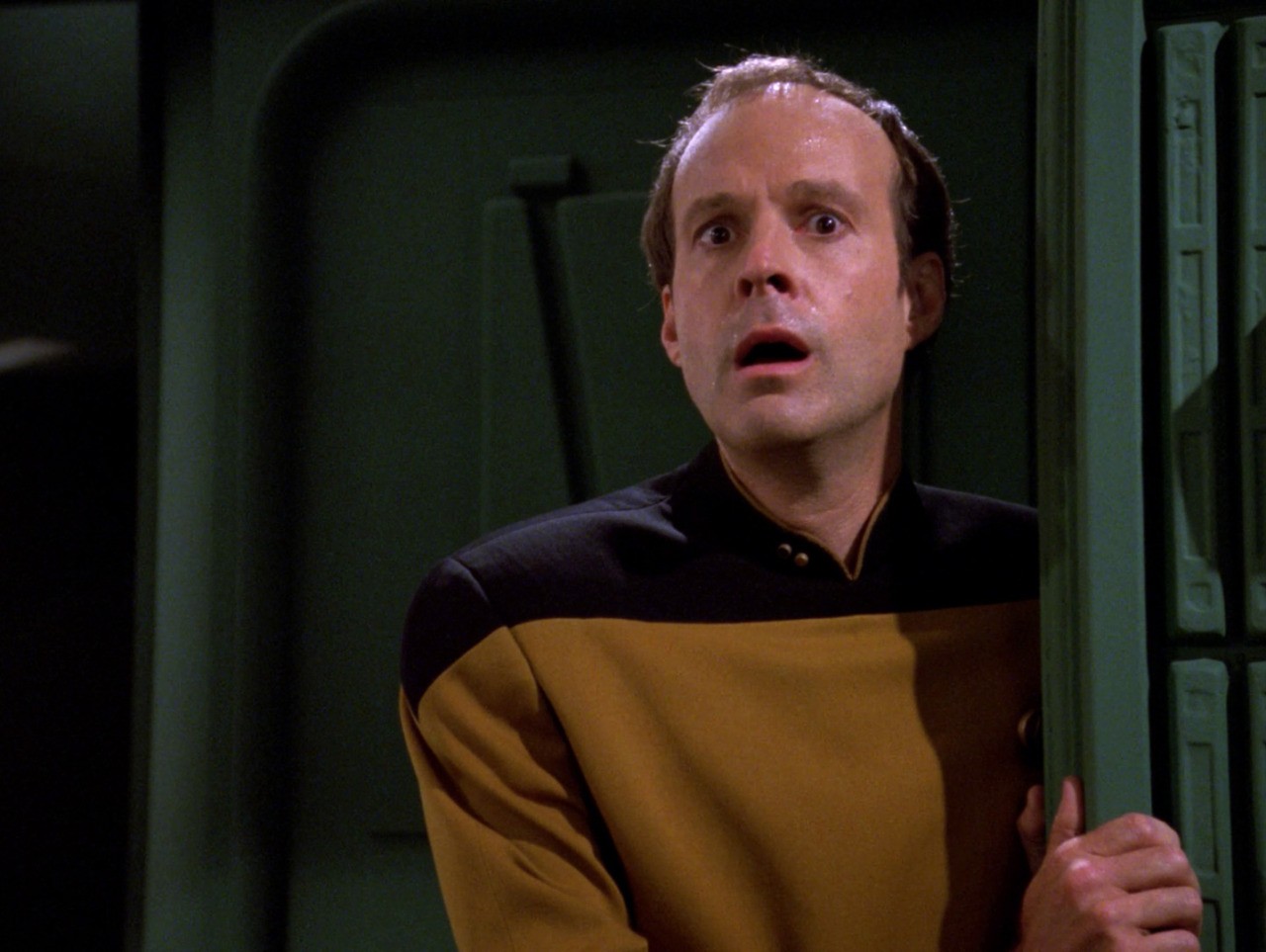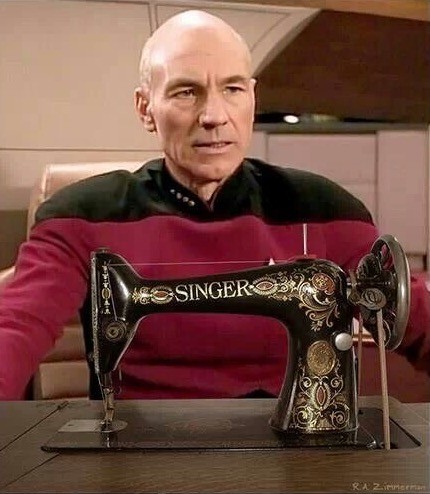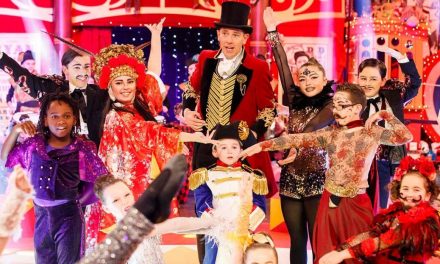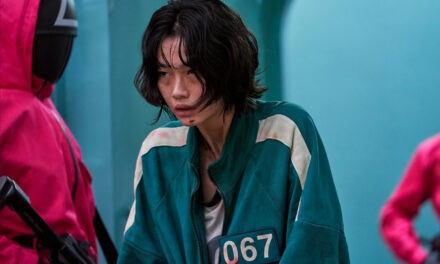Last week I told of my near-encounter with Patrick ‘Jean-Luc Picard’ Stewart of Star Trek: The Next Generation – not at Farpoint,[1] but in an Italian restaurant in Shad Thames back in 2011. This anecdote then acted as a springboard for an account of my on/off relationship with new Trek in the 1990s and early noughties, which – by the time I returned to these shores from Italy in 2008 – had seemingly withered on the vine.
This week, I shall tell of how the BluRay box set rekindled that particular first contact…
In Trek terms, the original series had always been my first love, and I’d seen those sixties episodes so many times that it was like welcoming an old friend home when I eventually purchased all three seasons on DVD (‘Corbomite Maneuver’, anyone?). I did not have the same relationship with TNG, but it was only when I eventually got the show on BluRay that I realised how little of it I had actually seen (basically season one, plus my friends’ recommendations, all of which were decades ago). At first, the box set looked a little intimidating up there on my shelf, and it was a month or two before I decided to venture once more towards the final frontier. However, over a year later, as I approach the last phase of my trek (I should be onto season seven by the time this goes out), I have come to appreciate the fact that, although I will always love the 60s and 70s adventures of Kirk’s crew best, TNG is a much more fully realised (I’m trying not to write ‘better’) version of Roddenberry’s original concept.
Yes, there are some clunky episodes – but the original series had more than its share of them (particularly in season three, by which time Roddenberry had lost interest and Fred Freiberger was producing titles like ‘Spock’s Brain’). Yes, the costumes in the first two seasons do look like pyjamas (but were apparently much less comfortable to wear). Yes, a little too much effort is made in the early episodes to re-tread the path of the original – usually when the same writers are involved, sometimes providing essentially the same storylines. ‘The Naked Now’, which is only the second TNG story, is basically a re-make of classic original series episode ‘The Naked Time’, which was far superior – if only due to the fact that, if you are going to have a story that centres around the regular cast losing all their inhibitions and behaving totally out of character, we first need to have actually got to know the regular cast a little.
However, TNG offers many compensations – not least because its lengthier run allows the characters and storylines the space to breathe and grow. Although still in series format, it offers a plenitude of on-going story threads that would have been inconceivable in the 1960s, when pretty much every episode had to end with the equilibrium re-set of McCoy growling that Spock was a damned, green-blooded Vulcan, while Kirk chuckled indulgently at this blatant example of species-ism (I’ve always loved Kelley’s performance – but come on). In this respect, TNG – which is now rapidly flying towards its fortieth anniversary – feels like a much more modern production. Although this is more obvious from season three onwards, by which time backstories have begun to be established for the regular cast (Data has discovered the brother he never knew he had; Worf has discovered the son he never knew he had; we have discovered the trombone we never knew Riker had – and so forth), and semi-regular characters have been fleshed out (Whoopi Goldberg is a gradually unfolding enigma as bartender Guinan from season two onwards – and who would have thought stolid transporter chief Miles O’Brien, who is little more than an extra in the early episodes, would end up getting married?). However, I have seen little evidence in my viewing marathon of the received wisdom that the first two seasons are extremely poor, and that the show then suddenly becomes excellent overnight. The seeds are there early on, not least in the performances of the lead cast, who begin to gel much faster than some of the early writing gave them the opportunity for. Seeds need to grow, and the chemistry between the regulars is one of the show’s most apparent strengths.
They are aided in this in that, unlike in the original series, each episode does not revolve primarily around a central cast of three or four characters. In Star Trek, the lion’s share of the narrative usually went to either Kirk or Spock, though Bones and Scotty each had the occasional episode in which to shine (think Bones meeting his former paramour – who turns out to be a salt vampire in disguise – or Scotty being charged with a murder he did not commit). For the other regulars, Uhura, Sulu, Chekov and Nurse Chapel (who I think had one episode in which she was given a crush on Spock – but just the one), it was usually hard lines – and not many of them. And how many of you remember poor old Janice Rand, shown the red card before season one was even over? On the original series there is very much a sense of delineation between lead and supporting cast that, while typical of the time, ultimately limits the show in terms of narrative possibilities.
Not so on TNG. Although Picard is top dog, and Riker his clear second in command (‘Take the helm, Number One’), lead storylines are shared more or less evenly between a sizeable regular cast; a benefit of having a true ensemble. It is difficult to imagine an episode of Star Trek that revolved almost entirely around Uhura falling in love with someone who turned out to be merely a physical host to a grub-like alien life form, which is what happens to Beverly Crusher when she gets steamy with a Trill in ‘The Host’. And don’t we feel a little resentful towards Bev when she’s so cold towards the female form her once-male lover ends up inhabiting at the end of the episode? This is complex, sophisticated stuff, which I’m sure the late Nichelle Nichols could have handled admirably – but she was never going to be given that opportunity on classic Trek.
Although the original series saw galactic ne’er-do-well Harry Mudd turning up twice (before returning again for the animated series to prove that a Tribble shared is a Tribble doubled), TNG’s plethora of recurring characters helps create the sense of a genuine storyworld, in which life aboard ship continues seamlessly between episodes. My personal favourite is nervy Reg Barclay, if only because I started chuckling as soon as I recognised actor Dwight Schultz, formerly The A-Team’s Howling Mad Murdoch. Reg could easily have been a one-hit wonder from his debut episode, ‘Hollow Pursuits’, in which he forms a near-addiction to the Holodeck by way of compensation for his inability to relate to his colleagues. By the end of the episode Geordi has taken Reg under his wing, and there are signs of him coming out of his shell. That could easily have been his lot on an episodic show like Star Trek, but Reg then begins cropping up once or twice a season, and while his hairstyles later vary alarmingly, Shultz does a consistently excellent job of portraying a man who, though not naturally confident, gradually overcomes his innate shyness, forming strong bonds with other members of the crew such as Geordi and Deanna.
Next Gen also introduces over-arching storylines that not only stretch across its own seasons but extend beyond into spin-offs such as Deep Space Nine and Voyager (which I have, admittedly, yet to watch). These include the new big bads the Borg, a gestalt cyborg collective who become a growing threat until factions begin to split off as a result of discovering their own sense of identity (‘Hugh’ is a particularly strong episode), while the Bajoran conflict with the Cardassians (another powerful new breed of antagonist) later forms the backdrop to DS9. Threads from the original series are also picked up and developed, Spock himself putting in an appearance in season five to attempt reunification between the Vulcans and their Romulan cousins.
This is all strong narrative stuff, and despite the occasional longueur (witness Picard – or indeed any character – falling in love for a week; see last week), I want to keep watching, partly because I would like to find out what happens next (despite the fact that, being a series, nothing fundamental can really change), and partly because I simply enjoy spending time with these characters. It’s a little like reading Doyle’s Sherlock Holmes short stories; after a while, 221B starts to feel like a home from home, and I am comfortably aware that, even if the next story is a dud, I will be on to another before too long.
It is, as a wise Trek scribe once wrote, the best of both worlds – and I have even purchased my own TNG Starfleet communicator pin to help get into the spirit of things.
That said, I can’t end my log without mentioning Picard, the TNG sequel (of sorts) that kicked off in 2020. Although the still-sprightly Picard rubs shoulders with some of his former colleagues (Data, Riker and Troi all crop up in season one; Q and Guinan in season two – and there are pleasing cameos for Hugh the Borg and Wes Crusher), the focus is firmly on a new cast of characters, promotion for the show emphasising that this was very much not Next Gen season eight. As a result, though there are enough call-backs to TNG to keep fans happy (not least Ito Aghayere’s excellent performance as a younger version of Guinan), the old Trek magic is not always there. This is hopefully being remedied in season three, which – while still going out as I write – has apparently reunited pretty much the whole crew of the Enterprise. I am trying to avoid spoilers until the BluRay is released – but wouldn’t it be good to know why Picard and Beverly never quite got it together? And which alphabet letter of the USS Enterprise are we on now, anyway?
Personally, I am hoping for a scene in which Picard gets down on one knee and proposes to his new love, Romulan housekeeper Laris (Orla Brady), by asking her to ‘Engage?’…
That probably won’t happen.
In the meantime, I still have TNG season seven to look forward to, and even if all good things must come to an end, there are then the various Next Gen movies to keep me going for a while. In the meantime, a quick Google search shows that I have already been beaten to the punchline as to what Patrick Stewart will say when presented with his wrap party retirement gift:
Dr Richard Hewett is Senior Lecturer in Contextual Studies for Film and Television at University of the Arts London. He has previously contributed articles to The Journal of British Cinema and Television, The Historical Journal of Film, Radio and Television, Critical Studies in Television, Adaptation, Comedy Studies and Series – International Journal of Serial Narratives. His 2017 monograph, The Changing Spaces of Television Acting, was published in paperback form in 2020. For further information on academic publications, see here.
Footnote
[1] This is a reference to the title of the first TNG episode – but you knew that, right?







